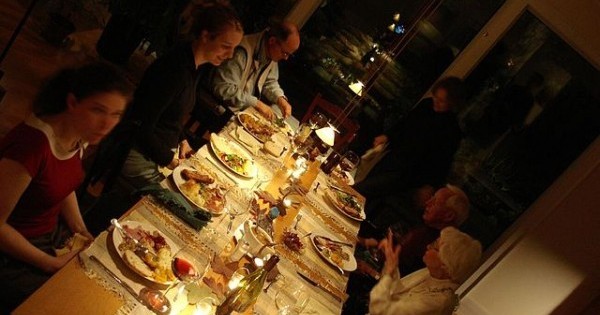
I’ve been trying to imagine Norman Rockwell trying to paint the modern American family gathered around the Thanksgiving dinner table. For more than four decades Rockwell was the custodian of our domestic mythology, mainly with his cover illustrations for The Saturday Evening Post. Those covers fixed in our collective memory the sacramental moments of small-town life—Bobby’s first haircut, Barb’s first prom—and its supporting cast of butchers, bakers, teachers, preachers, judges, cops, and other kindly bulwarks of stability and order.
Rockwell’s American family was a tidy unit that came in a standard package: Granny and Gramps, Mom and Dad, children and grandchildren, uncle and aunt, and a dog that looked like a dog. Children often had freckles. (Whatever became of freckles?) Everyone was happy. No issues.
Today no magazine cover would be wide enough for Rockwell. He would need a Chinese scroll to accommodate the motley crowd assembled to eat turkey or some dietetically certified substitute: single moms, single dads, partners, companions, half brothers, half sisters, stepchildren, ex-spouses, live-ins, live-outs, in-laws, outlaws, and dogs of rarefied lineage. Only an artist from a post-Rockwell school of painting—perhaps an abstract expressionist—could hope to catch the overlapping fluidities of the modern American tribe.
My candidate would be a painter from an even more recent generation: the 79-year-old pioneer of conceptualism, John Baldessari, whose hugely influential body of work is available for deconstruction in a retrospective that has just opened at the Metropolitan Museum of Art. Reviewing that show for New York magazine, the critic Jerry Saltz noted that Baldessari’s art usually incorporates a photo or a grid of grainy black-and-white pictures. “But after 1980,” he writes, “when Baldessari went from small and uncertain to big, klunky, and fragmented, the results get formulaic and optically awkward, involving dots of color over faces, cutout shapes, and irregularly hung framed pictures.” Many of those words could describe the modern extended family: big, klunky, fragmented, optically awkward, irregular. But somehow it works.
For me the idea of Thanksgiving was not instilled by an artist. That happened on a plane ride over Iowa, many Novembers ago. My wife and I were flying to Cedar Rapids to spend the holiday with her parents. At that time propeller planes flew low over America, and around midday I began to notice a recurring pattern on the snow-coated landscape below. Cars and pickup trucks, presumably loaded with husbands and wives and kids, kept turning off the arrow-straight county roads and into the yard of the ancestral farmhouse—the one that had a barn. America was coming home.
The families coming home for Thanksgiving this year will be differently configured, more Baldessari than Rockwell. But nothing ever changes the event itself. Thanks are given for the bounty of the earth. Blessings are asked for the nation and its freedoms. The baby born since the last Thanksgiving is shown off and declared the most beautiful baby ever. A meal is shared; a family’s fabric stitched back together for a few hours.
Then, suddenly, across America, an invisible switch is thrown, terminating words are spoken (“Get your coat,” “When’s the next train?”), and the best of holidays is over for another year.


